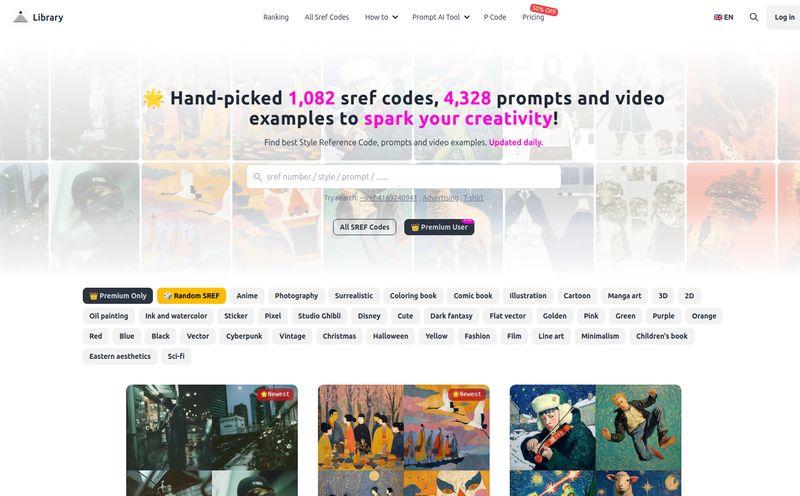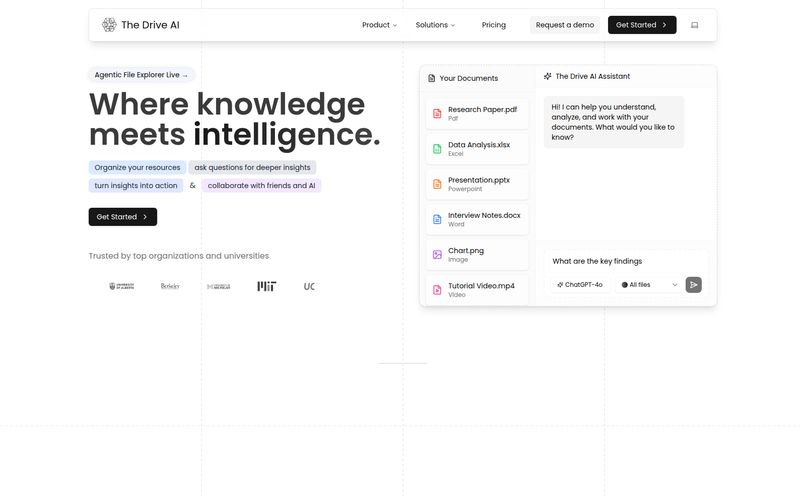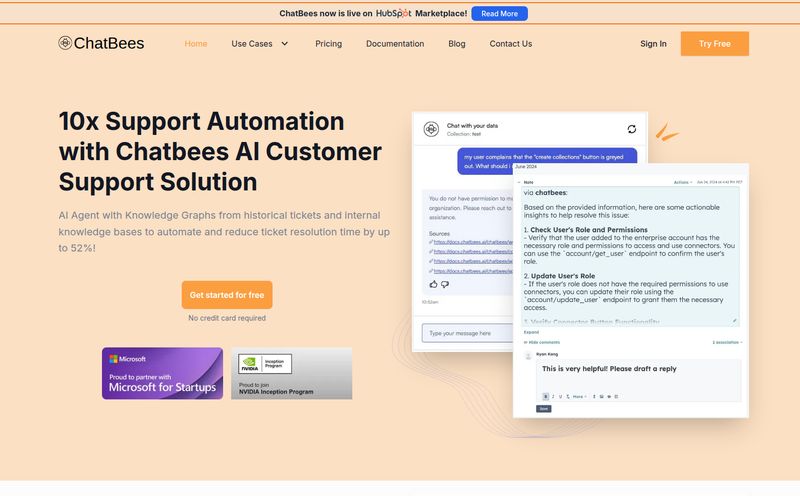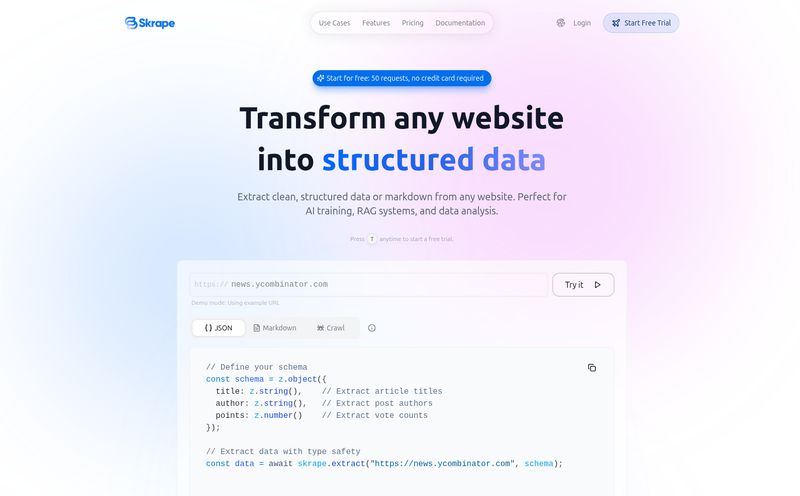We’ve all been there, trapped in a chatbot loop from hell. You ask a simple question, and the bot responds with a completely unrelated, pre-programmed answer. You rephrase. It gives you the same useless response. Before you know it, you're furiously typing “speak to a human” and your blood pressure is doing the Macarena. It's a universally frustrating experience.
For years, I've been pretty cynical about chatbots for most businesses. They often feel like a barrier, not a help. A cheap way to deflect customers rather than serve them. But every now and then, a tool comes along that makes me sit up and pay attention. Recently, that tool was TunedChat.
The premise is simple, but powerful: an AI chatbot that you train on your own content. No generic scripts. No canned responses that don't fit your brand. Just a bot that knows your business because it's learned from your business. It’s an interesting idea, right? So, I decided to take a closer look.

Visit TunedChat
So, What is TunedChat, Really?
Imagine hiring a new support agent. But instead of a week of onboarding, you just hand them your entire website, your help documents, your product manuals, and your FAQs. You tell them, "Read all of this. This is your entire world now." That's essentially TunedChat. It’s an AI platform that ingests your content and builds a custom chatbot from it.
This isn't your average, run-of-the-mill, decision-tree bot. It's using AI to understand the context and nuance of the information you provide. The goal is to answer customer questions instantly, accurately, and in a way that sounds like it’s actually coming from your company. And here’s the kicker – it can do it in multiple languages, right out of the box. That’s a pretty big claim.
Why Your Business Might Actually Need This
I see a lot of shiny new AI tools every week. Most are solutions looking for a problem. TunedChat, however, targets a pain point that is almost universal: the sheer volume of repetitive customer support inquiries. You know the ones. The “How do I reset my password?” or “What’s your return policy?” questions that clog up your inbox and keep your support team from handling the really complex issues.
Automating the first line of defense for these common questions can be a game-changer. It’s not about firing your support team; it's about freeing them up. It’s about letting them focus on high-value interactions that require a human touch, while the bot handles the routine stuff 24/7. And happier customers who get instant answers? That's just good business. It improves productivity, sure, but more importantly, it can drastically improve the customer experience.
A Peek Under the Hood at the Features
Alright, let's get into the nitty-gritty. What does this thing actually do?
Your Content Becomes the Chatbot's Brain
The core of TunedChat is its training process. You can point it to your website, and it will crawl the pages to learn the information. Or, you can upload specific documents—PDFs, Word docs, you name it. This is both its greatest strength and its most important caveat. The bot is only as smart as the information you give it. If your help docs are outdated or your website is a mess, your bot will be too. Garbage in, garbage out, as the old programming saying goes. So, a little spring cleaning of your content might be in order before you let the AI loose.
Speaking Your Customer's Language, Literally
This is the feature that really caught my eye. The promise of being multilingual isn't just a tacked-on translation feature. It's built into the core. A customer can ask a question in Spanish, and the bot, having learned from your English content, can understand the query and respond accurately in Spanish. This is huge for companies looking to expand their global reach without hiring a massive, multilingual support team from day one. It breaks down language barriers in a way that feels almost like magic.
Making the Bot Your Own
Nobody wants a robot that sounds like, well, a robot. TunedChat gets this. You can customize the chatbot’s personality to reflect your brand's voice. Want a friendly and slightly quirky bot for your DTC brand? Go for it. Need a more formal, professional tone for your B2B service? You can do that too. This customization extends to the look and feel of the chat widget, ensuring it integrates nicely with your website design. It’s these little touches that separate a good tool from a great one.
The Good, The Bad, and The AI
No tool is perfect, and I'm not here to sell you snake oil. Let's have a real chat about the upsides and the potential downsides.
On the plus side, the benefits are clear. You can seriously cut down on the number of basic support tickets, which saves an incredible amount of time and money. Your team’s productivity goes up, and customers get instant gratification. The setup is also designed to be easy, meaning you don't need a degree in computer science to get it running. That’s a big win for small to medium-sized businesses.
However, there are limitations. As I mentioned, the chatbot's knowledge is confined to what you've provided. It can't answer questions about topics outside its knowledge base. If a customer asks about a brand-new feature you haven't documented yet, the bot will be stumped. This means you have to be diligent about keeping its knowledge base updated. It’s not a “set it and forget it” solution. It’s more like a garden that needs regular tending.
"Think of it less as a replacement for your team and more as your team's most dedicated, tireless assistant."
So, How Much Does This Magic Cost?
Ah, the million-dollar question. Or, hopefully, a lot less than a million dollars. As of my review, TunedChat doesn't have a public pricing page. This is pretty common for B2B SaaS platforms that tailor their pricing to the client's needs (think: volume of queries, number of bots, etc.).
While I can't give you a hard number, this typically means you’ll need to contact their sales team for a quote. Don't let that scare you off. It often means they want to understand your use case to ensure you're a good fit. My advice? Go in with a clear idea of your monthly support ticket volume and what you're hoping to achieve. This will help you have a much more productive conversation.
Final Thoughts: Is TunedChat the Future?
So, is TunedChat the revolutionary tool it claims to be? I'm cautiously optimistic. I think it's a significant step in the right direction. The idea of a chatbot that learns from your specific content and speaks to customers in their own language is incredibly appealing.
It’s not a silver bullet that will solve every customer support problem. You still need skilled humans for complex issues and for managing the AI itself. But for businesses drowning in repetitive questions and looking for a smart, scalable way to provide instant support, TunedChat is definitely a platform worth investigating. It might just be the tool that turns your customer support from a cost center into a genuine competitive advantage.
Frequently Asked Questions about TunedChat
What kind of content can I use to train a TunedChat bot?
You can train it on a wide variety of content. The most common methods are pointing it to your live website for it to crawl, or by uploading files directly. This can include PDFs, DOCX files, text files, and more. Essentially, any text-based document containing the information you want the bot to know can be used.
Is TunedChat difficult to integrate with my website?
From what I've seen, the integration process is designed to be very straightforward. Typically, it involves adding a small snippet of code to your website's HTML, similar to how you would install Google Analytics or another third-party script. They aim for a "no-code" or "low-code" experience, so you shouldn't need a developer for the basic setup.
How does the multilingual feature actually work?
It's not just a simple word-for-word translation. The AI model is designed to understand the intent of a question in one language (e.g., French) and find the relevant answer within its knowledge base (which might be in English), then formulate a natural-sounding, accurate response in the original language (French). It’s a more sophisticated approach than a simple Google Translate plugin.
Will TunedChat completely replace my human support team?
Absolutely not. That's not the goal. The idea is to augment your human team, not replace them. The bot handles the high-volume, low-complexity questions, which frees up your human agents to focus on the nuanced, sensitive, or complex issues where their skills are most valuable.
What happens if a customer asks a question the bot can't answer?
Good chatbot platforms have a built-in escalation path. If TunedChat can't find an answer or recognizes the user is frustrated, it should be configurable to seamlessly hand the conversation over to a live human agent, create a support ticket, or provide contact information. The worst thing a bot can do is leave a user in a dead end.
Okay, really, how much does TunedChat cost?
As mentioned, they don't list prices publicly. You'll have to reach out to them for a custom quote based on your specific needs, like website traffic and the number of conversations you expect. This is a common practice for specialized B2B software.
References and Sources
TunedChat Official Website: Information and features were analyzed from the platform's public information.
HubSpot's Customer Service Stats: For general context, data from resources like HubSpot's research on customer expectations often shows that a majority of consumers expect an immediate response to their support queries, highlighting the need for tools like AI chatbots.



